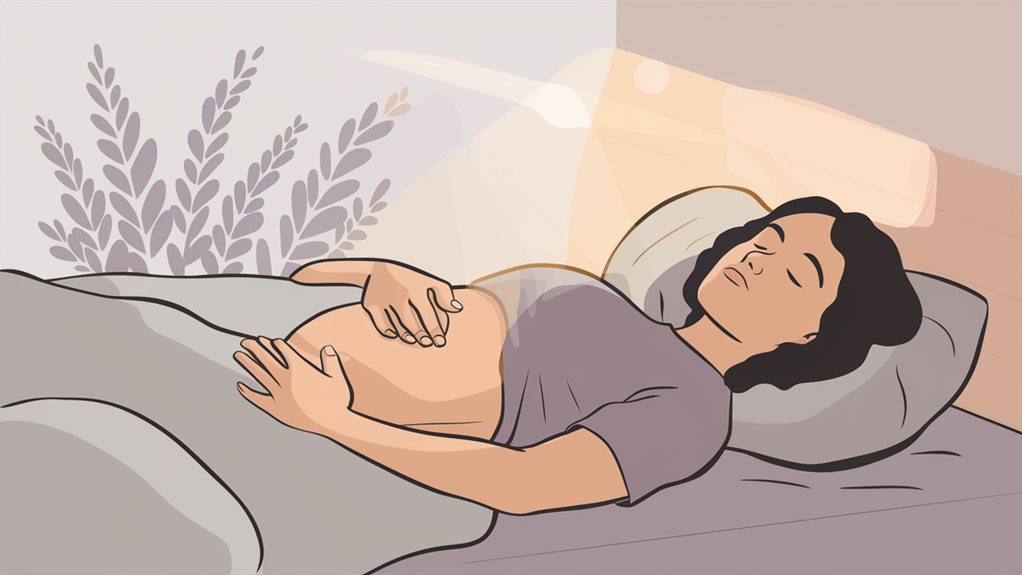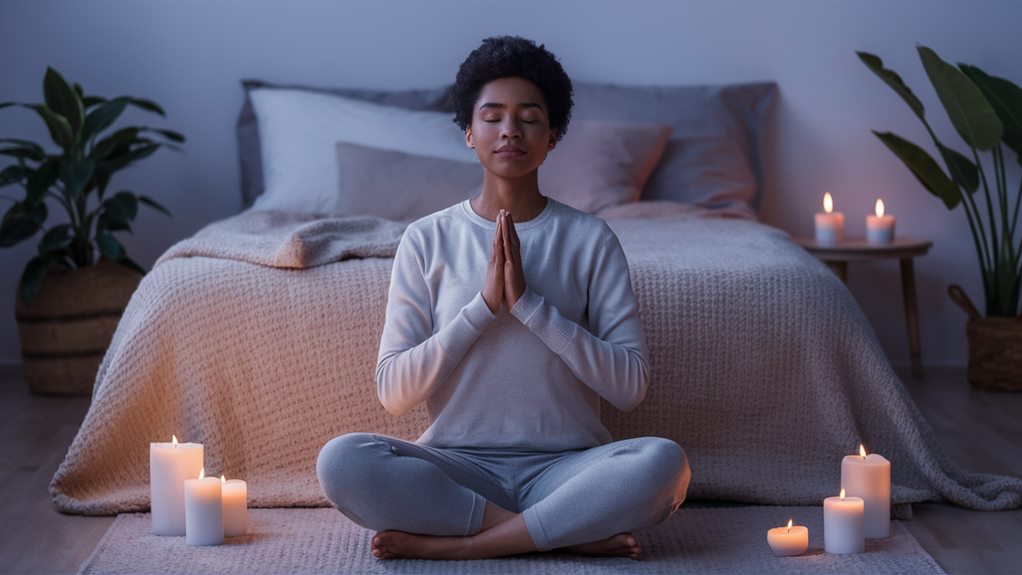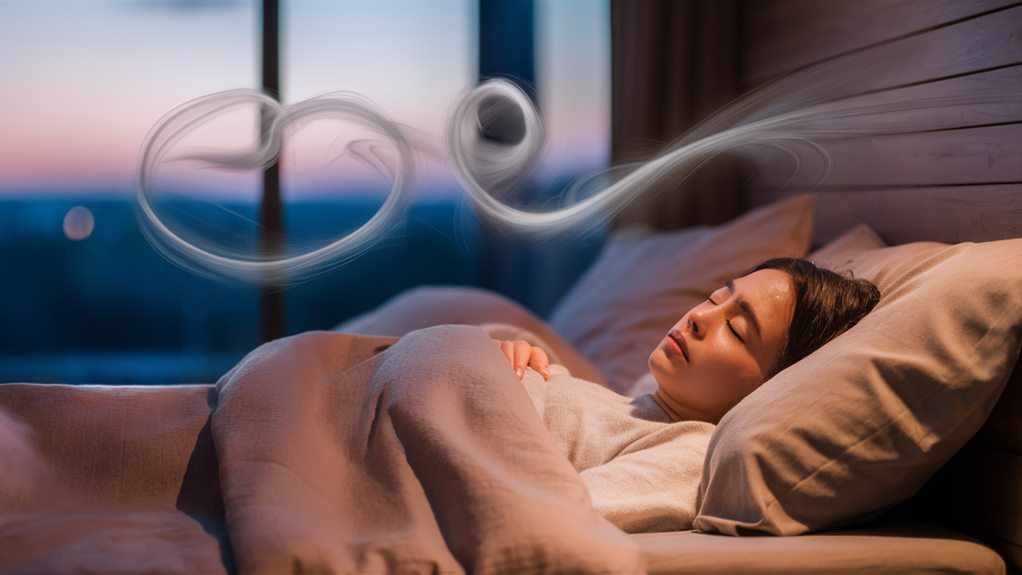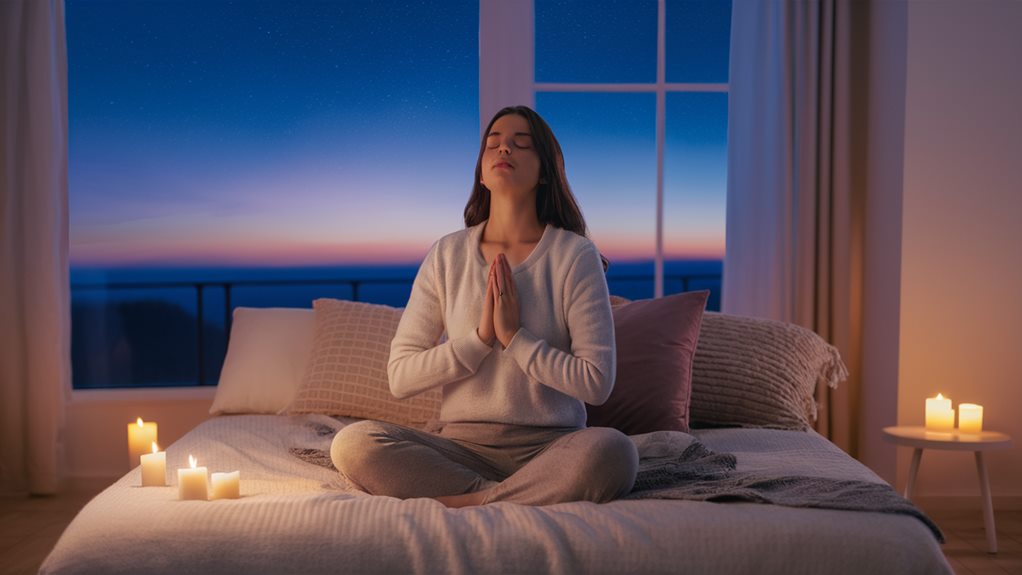To improve your sleep quality, try these seven breathing exercises. Start with diaphragmatic breathing to engage your diaphragm fully and calm your mind. Use the 4-7-8 technique to ground yourself and lower your heart rate. Box breathing can relieve stress and enhance clarity. Alternate nostril breathing balances your energy and promotes relaxation. Incorporate progressive muscle relaxation to identify tension areas in your body. Practicing extended exhalation helps calm your thoughts and releases stress. Finally, mindful breathing cultivates presence and serenity. By integrating these methods into your routine, you can discover the path to deeper, restful sleep. There's much more to explore!
Key Takeaways
- Diaphragmatic Breathing: Fully engage the diaphragm to increase air intake, reduce anxiety, and promote a calm mind before sleep.
- 4-7-8 Breathing Technique: Inhale for 4 seconds, hold for 7, and exhale for 8 to lower heart rates and quiet racing thoughts.
- Box Breathing: Inhale, hold, exhale, and hold each for 4 counts to relieve stress and cultivate a sense of clarity and calm.
- Alternate Nostril Breathing: Practice breathing through one nostril at a time to balance energy and create a tranquil environment for sleep.
- Extended Exhalation: Focus on longer exhalations to activate the parasympathetic nervous system, reducing tension and preparing the mind for restful sleep.
Diaphragmatic Breathing

Diaphragmatic breathing, often referred to as belly breathing, can greatly enhance your sleep quality. This technique encourages you to engage your diaphragm fully, allowing more air to fill your lungs and promoting relaxation. Incorporating nutritional practices, such as adding nutritional yeast to your evening meals, may also complement your relaxation routine by providing essential nutrients that support overall well-being. By practicing diaphragmatic breathing regularly, you can enjoy various benefits, including reduced anxiety, improved focus, and a calmer mind as bedtime approaches.
To get started, find a comfortable position—lying down or sitting. Place one hand on your chest and the other on your belly. As you breathe in through your nose, let your belly rise while keeping your chest relatively still. Exhale slowly through your mouth, feeling your belly fall. Repeat this process for several minutes, focusing on the rhythm of your breath.
The benefits of incorporating diaphragmatic breathing into your nightly routine are invaluable. Not only does it help lower stress levels, but it also prepares your body for restful sleep. As you practice this technique, you'll likely notice a shift in your overall mood and energy levels, fostering a greater sense of belonging within yourself.
If you're struggling with racing thoughts or tension before sleep, give diaphragmatic breathing a try. It's a simple yet powerful practice that can transform your nighttime routine, helping you feel more connected to your body and mind. Embrace this technique and discover the restorative benefits it can bring to your life, nurturing a deeper sense of peace and well-being.
4-7-8 Breathing Technique

After experiencing the calming effects of diaphragmatic breathing, you might want to explore another effective technique known as the 8-Breathing Technique. This method involves a simple pattern: inhale for a count of four, hold your breath for a count of two, and exhale for a count of four. You'll repeat this cycle eight times, facilitating a sense of tranquility and grounding that can be particularly useful as bedtime approaches.
Incorporating relaxation techniques, like the 8-Breathing Technique, can enhance your sleep experience, much like melatonin supplements do. Research has shown that the 8-Breathing Technique not only helps lower heart rates but also reduces anxiety, making it easier for you to drift off to sleep. Effectiveness studies indicate that practicing this technique regularly can enhance your overall sleep quality. The benefits are clear: by focusing on your breath, you create a mindful space that allows your thoughts to quieten, fostering a sense of belonging within yourself.
To practice this technique, find a comfortable position, whether sitting or lying down. Close your eyes and take a moment to feel your body relax. As you begin the cycle, visualize each breath as a wave, washing away the stresses of the day.
The more you practice these techniques, the more natural they'll become, allowing you to tap into that calming effect whenever you need it.
Box Breathing

Box Breathing, a simple yet powerful technique, can be your ticket to a more peaceful night's sleep. This method involves inhaling, holding, exhaling, and pausing, each for a count of four. It's structured, making it easy to remember and practice. As you engage in this rhythmic breathing, you'll find it serves as an effective tool for stress relief and anxiety reduction, similar to how a comfortable gardening experience can enhance your overall well-being.
To start, find a comfortable position, either sitting or lying down. Close your eyes and take a deep breath in through your nose for a count of four. Hold that breath for another count of four, letting the air fill your lungs completely. Then, slowly exhale through your mouth for four counts, releasing any tension you might be holding. Finally, pause for four counts before repeating the cycle.
You might notice how each round helps ground you, bringing a sense of calm and clarity. By focusing on your breath, you're not just calming your mind; you're also giving yourself permission to let go of the day's worries.
Over time, this practice can help you develop a stronger connection with your body and emotions, fostering a sense of belonging within yourself.
Incorporating Box Breathing into your nightly routine can transform your sleep quality. As you embrace this technique, you'll likely experience a profound sense of relaxation, paving the way for restorative sleep. Remember, you deserve those peaceful nights.
Alternate Nostril Breathing

Harnessing the power of breath, Alternate Nostril Breathing offers a unique way to enhance your sleep quality. This technique not only promotes relaxation but also helps you find a sense of balance in your energy. By focusing on your breath, you can create a calming environment that encourages restful sleep.
To practice Alternate Nostril Breathing, sit comfortably and relax your shoulders. Using your right thumb, gently close your right nostril. Inhale deeply through your left nostril for a count of four, then close your left nostril with your ring finger. Open your right nostril and exhale slowly for a count of four.
Inhale through your right nostril, close it, and exhale through your left. This simple cycle helps harmonize your body's energies, making it easier to let go of daily stress.
As you engage in this practice, you'll likely notice a sense of stress relief washing over you. Each breath serves as a reminder to release tension and embrace tranquility. This rhythmic pattern not only calms your mind but also signals your body that it's time to unwind.
Incorporating Alternate Nostril Breathing into your nightly routine can transform your sleep experience. You'll feel more grounded and connected, fostering a deeper sense of belonging within yourself. So, take a moment tonight to breathe deeply, center your energies, and drift into a peaceful sleep, knowing you've nurtured both your mind and body.
Progressive Muscle Relaxation

Progressive Muscle Relaxation (PMR) is an effective technique for alleviating tension and promoting better sleep quality. By focusing on systematically tensing and relaxing different muscle groups, you can enhance your overall relaxation experience. It's a simple yet powerful method that encourages mindfulness and allows you to connect with your body, making it a valuable addition to your relaxation techniques.
To start, find a quiet, comfortable space where you won't be disturbed. Take a moment to settle in and close your eyes. Begin with your toes, tensing them for about five seconds before releasing. Notice the difference between tension and relaxation. Gradually work your way up through each muscle group—your calves, thighs, abdomen, arms, and face—spending a few moments on each. This practice not only helps you identify where you hold stress but also cultivates a deeper state of relaxation.
As you progress through the muscle groups, you'll likely find that your mind begins to quieten, paving the way for sleep improvement. It's a comforting routine that fosters a sense of belonging, as you recognize that many others also seek restful nights through similar practices.
PMR can be especially beneficial after a long day, helping you unwind and let go of accumulated stress. Embrace this technique, and you may discover a newfound ease in your journey to restful sleep, creating a peaceful sanctuary for your mind and body to recharge.
Extended Exhalation

Practicing extended exhalation can greatly enhance your sleep quality by promoting relaxation and reducing stress levels. This simple yet effective technique involves taking a deep breath in and then exhaling slowly, allowing your body to release tension and calm your mind. As you focus on elongating your exhalation, you'll notice how it helps you let go of the day's worries and prepares you for a restful night.
The sleep benefits of extended exhalation are profound. By emphasizing longer exhales, you activate your parasympathetic nervous system, which is responsible for relaxation. This shift can lead to a decrease in heart rate and blood pressure, creating a soothing environment for sleep.
As you incorporate this practice into your bedtime routine, you'll find that it enhances your ability to drift off peacefully, making those sleepless nights a thing of the past.
Moreover, extended exhalation serves as an excellent tool for stress relief. When you consciously focus on your breath, you create a moment of mindfulness that helps to break the cycle of anxious thoughts. This practice fosters a sense of belonging to yourself, allowing you to acknowledge your feelings and embrace tranquility.
Try dedicating a few minutes each evening to this technique. Not only will you reap the rewards of better sleep, but you'll also develop a deeper connection with your body and mind, fostering a greater sense of peace and well-being. You deserve restful nights and rejuvenated mornings, so start practicing extended exhalation tonight!
Mindful Breathing

Mindful breathing is a powerful technique that can transform your approach to sleep by grounding you in the present moment. By engaging in this mindfulness practice, you create a serene environment conducive to rest. It's all about tuning in to your breath and letting go of the day's stressors, which is essential for good sleep hygiene.
As you sit or lie down comfortably, close your eyes and take a deep breath in through your nose, feeling your abdomen expand. Hold that breath for a moment, and then gently exhale through your mouth. Focus on how your body feels with each breath. This simple relaxation technique not only calms your mind but also helps manage stress effectively.
Incorporating mindful breathing into your nightly routine can work wonders. You might find that as you practice consistently, your ability to drift off to sleep improves. It's about finding a rhythm that suits you, allowing the worries of the day to fade away. Remember, even a few minutes can yield significant benefits.
Frequently Asked Questions
How Long Should I Practice Breathing Exercises for Better Sleep?
When you're considering how long to practice breathing exercises, aim for about 10 to 15 minutes daily. This ideal duration allows you to reap significant sleep benefits without feeling overwhelmed.
You'll find that consistency is key; even short sessions can help calm your mind and body. By dedicating this time to yourself, you're fostering a sense of belonging and self-care that enhances your overall well-being.
Can Breathing Exercises Replace Sleep Medication?
Can breathing exercises replace sleep medication? While they won't entirely substitute for medication, they can serve as effective natural alternatives, especially for those seeking healthier sleep patterns.
By incorporating these exercises into your routine, you'll likely experience long-term benefits, like reduced anxiety and improved relaxation.
It's crucial to listen to your body and find what works best for you, creating a sense of belonging in a community that prioritizes holistic health.
Are Breathing Exercises Safe for Everyone?
Think of breathing exercises as a gentle river, flowing through your life. They're generally safe for most people, but personal variations in health can create unexpected ripples.
If you have certain health risks, like respiratory issues or cardiovascular conditions, it's wise to consult a healthcare professional before diving in. You want to guarantee that your journey into relaxation is both soothing and safe, allowing you to truly embrace the calming benefits they offer.
How Quickly Can I Expect Results From Breathing Exercises?
You can expect to see some immediate benefits from breathing exercises, often within just a few minutes. Measuring progress might take a bit longer, as it varies for everyone.
You'll likely feel more relaxed and centered right away, but long-term results depend on consistency. Remember, it's a journey, and every small step counts. Embrace the process, and you'll find a sense of belonging in your growth and improvement.
What Are the Best Times to Practice Breathing Exercises?
You think you're too busy to breathe, huh? Well, let's change that!
The best times to practice breathing exercises are during your morning routine to kickstart your day, and in your evening routine to unwind.
Don't forget a pre-bedtime session to ease into sleep.
Sneak in a midday break, too—your mind will thank you!
Embrace these moments, and you'll feel more centered and connected, just like everyone else in this hectic world.
Conclusion
Improving your sleep quality can be as simple as focusing on your breath. Did you know that nearly 70 million adults in the U.S. struggle with sleep disorders? By incorporating these breathing exercises into your nightly routine, you can reduce stress and promote relaxation, setting the stage for restful sleep. Remember, it's not just about quantity; it's about the quality of your sleep. So tonight, take a few moments to breathe deeply and embrace the calm.

